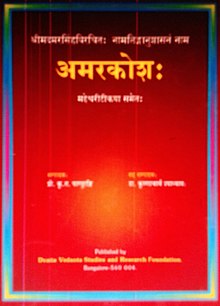| Revision as of 00:01, 29 September 2016 editRoland zh (talk | contribs)Autopatrolled, Extended confirmed users, Pending changes reviewers121,090 editsm ±Category:Indian poets→Category:Indian male poets; ±Category:4th-century writers→Category:4th-century Indian poets using HotCat← Previous edit | Revision as of 09:38, 9 February 2017 edit undoNyanatusita (talk | contribs)Extended confirmed users785 edits Added multiple issues. Added author's name in IAST Sanskrit diacritics. Added links to authors date.Next edit → | ||
| Line 1: | Line 1: | ||
| {{Multiple issues| | |||
| {{refimprove|date=February 2017}} | |||
| }} | |||
| ] | ] | ||
| '''Amara Sinha''' (or '''Amara Simha'''<ref name=Chambers/>) (c. CE 375) was a ] ]ian and ], of whose personal history hardly anything is known.{{citation needed|date=October 2014}} | '''Amara Sinha''' (or '''Amara Simha'''<ref name=Chambers/>, IAST: Amarasiṃha)) (c. CE 375) was a ] ]ian and ], of whose personal history hardly anything is known.{{citation needed|date=October 2014}} | ||
| He is said to have been "one of the nine gems that adorned the throne of ]," and according to the evidence of ], this is the ] (]) that flourished about CE 375.{{sfn|Chisholm|1911}} | He is said to have been "one of the nine gems that adorned the throne of ]," and according to the evidence of ], this is the ] (]) that flourished about CE 375.{{sfn|Chisholm|1911}}<ref>Amarakosha compiled by ], edited by N.Balasubramanya, 1970, page X</ref> | ||
| Other sources describe him as flourishing in |
Other sources describe him as flourishing in the 7th century.<ref name=Chambers>"Amara-Simha" in '']''. London: ], 1961, Vol. 1, p. 311.</ref> | ||
| The first reliable mention of the Amarakosha is in the Amoghavritti of Shakatayana composed during the reign of ](814-867CE)<ref> | |||
| </ref> | |||
| Most of |
Most of Amarasiṃha's work was destroyed, with the exception of the celebrated '']'' (''Treasury of Amara''), a vocabulary of Sanskrit roots, in three books, and hence sometimes called ''Trikanda'' or the "Tripartite". {{sfn|Chisholm|1911}} It is also known as "Namalinganushasana".{{cn|date=November 2015}} | ||
| The Amarakosha contains 10,000 words, and is arranged, like other works of its class, in metre, to aid the memory. The first chapter of the ''Kosha'' was printed at ] in Tamil character in 1798. An edition of the entire work, with English notes and an index by ] appeared at ] in 1808. The Sanskrit text was printed at ] in 1831. A French translation by ] was published at ] in 1839. {{sfn|Chisholm|1911}} | |||
| ] compiled the ] version of it and its available 4th edition was printed in 1927 which contains three khandas and 25 sargas.<ref>Amarakosha by Louie Rice edited by N.Balasubhramanyam</ref> | ] compiled the ] version of it and its available 4th edition was printed in 1927 which contains three khandas and 25 sargas.<ref>Amarakosha by Louie Rice edited by N.Balasubhramanyam</ref> | ||
Revision as of 09:38, 9 February 2017
This article has multiple issues. Please help improve it or discuss these issues on the talk page. (Learn how and when to remove these messages)
|

Amara Sinha (or Amara Simha, IAST: Amarasiṃha)) (c. CE 375) was a Sanskrit grammarian and poet, of whose personal history hardly anything is known.
He is said to have been "one of the nine gems that adorned the throne of Vikramaditya," and according to the evidence of Xuanzang, this is the Chandragupta Vikramaditya (Chandragupta II) that flourished about CE 375. Other sources describe him as flourishing in the 7th century. The first reliable mention of the Amarakosha is in the Amoghavritti of Shakatayana composed during the reign of Amoghavarsha(814-867CE)
Most of Amarasiṃha's work was destroyed, with the exception of the celebrated Amara-Kosha (Treasury of Amara), a vocabulary of Sanskrit roots, in three books, and hence sometimes called Trikanda or the "Tripartite". It is also known as "Namalinganushasana".
The Amarakosha contains 10,000 words, and is arranged, like other works of its class, in metre, to aid the memory. The first chapter of the Kosha was printed at Rome in Tamil character in 1798. An edition of the entire work, with English notes and an index by HT Colebrooke appeared at Serampore in 1808. The Sanskrit text was printed at Calcutta in 1831. A French translation by ALA Loiseleur-Deslongchamps was published at Paris in 1839. Louie Rice compiled the Kannada version of it and its available 4th edition was printed in 1927 which contains three khandas and 25 sargas.
References
- ^ "Amara-Simha" in Chambers's Encyclopædia. London: George Newnes, 1961, Vol. 1, p. 311.
- ^ Chisholm 1911.
- Amarakosha compiled by B.L.Rice, edited by N.Balasubramanya, 1970, page X
- Literary and Historical Studies in Indology, Vasudev Vishnu Mirashi, , Motilal Banarsidass Publ., 1975, p. 50-51
- Amarakosha by Louie Rice edited by N.Balasubhramanyam
- Attribution
 This article incorporates text from a publication now in the public domain: Chisholm, Hugh, ed. (1911). "Amara Sinha". Encyclopædia Britannica. Vol. 1 (11th ed.). Cambridge University Press.
This article incorporates text from a publication now in the public domain: Chisholm, Hugh, ed. (1911). "Amara Sinha". Encyclopædia Britannica. Vol. 1 (11th ed.). Cambridge University Press.